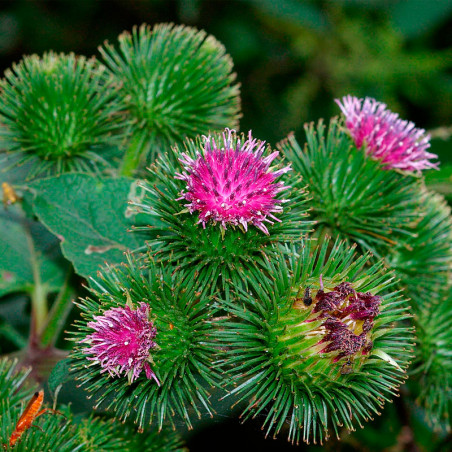







Arctium lappa, commonly known as Greater Burdock, is a perennial plant with robust stems and large leaves, found in damp, sunny areas. Its purple flowers form spiny heads that produce fruits with small hooks, known for sticking easily to clothing or animal fur. Additionally, its roots and leaves are used in the production of cosmetic products and traditional cooking.
Arctium lappa, commonly known as Greater Burdock, is a perennial plant found in damp, sunny soils across Europe, Asia, and North America. It has a robust stature, with erect stems and large, oval-shaped leaves with serrated edges. It can grow up to 2 meters in height, making it an imposing plant in its natural environment.
Historically, Greater Burdock was used as an edible vegetable, particularly its roots, which were cooked in various dishes. The taste of the immature stems is similar to that of artichoke, making it a popular ingredient in cooking. Over time, its consumption declined, but in the 20th century, it regained popularity due to its inclusion in the macrobiotic diet, especially for its health benefits.
In Japan, Arctium lappa is known as Gobo and is widely used in traditional cuisine, where its roots are prepared in soups, stews, and salads. The plant’s purple flowers form globe-like heads surrounded by spiny bracts, while the fruits, with small hooks, easily cling to clothing or animal fur, aiding in its dispersion.
In addition to its culinary uses, Greater Burdock is also valued in cosmetics, with its roots and leaves being used in the production of creams and soaps for their skin benefits. In gardens, it is a hardy plant that adds a rustic, characterful touch, ideal for damp soils and partial shade areas.
Burdock should be sown directly into the soil, as it does not tolerate transplanting well due to its long taproot. Choose a location with full sun or partial shade, and deep, loose, well-drained soil rich in organic matter.
Sow the seeds in spring after the last frost, or in autumn in mild climates. Direct sow in rows or broadcast, covering them with about 1 cm of soil, and keep the substrate slightly moist. Germination usually occurs in 7 to 14 days at temperatures between 15 and 20 °C.
Once the seedlings reach about 10 cm in height, thin them out to 30 to 50 cm apart, allowing enough room for the roots to grow properly.
This is a biennial plant: in the first year it forms a large rosette of leaves and develops its edible root. If not harvested, it will flower in the second year, attracting pollinators and producing seeds.

| January | February | March | April | May | June | July | August | September | October | November | December |
Data sheet
No customer questions for the moment.